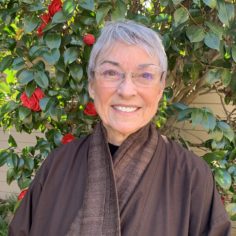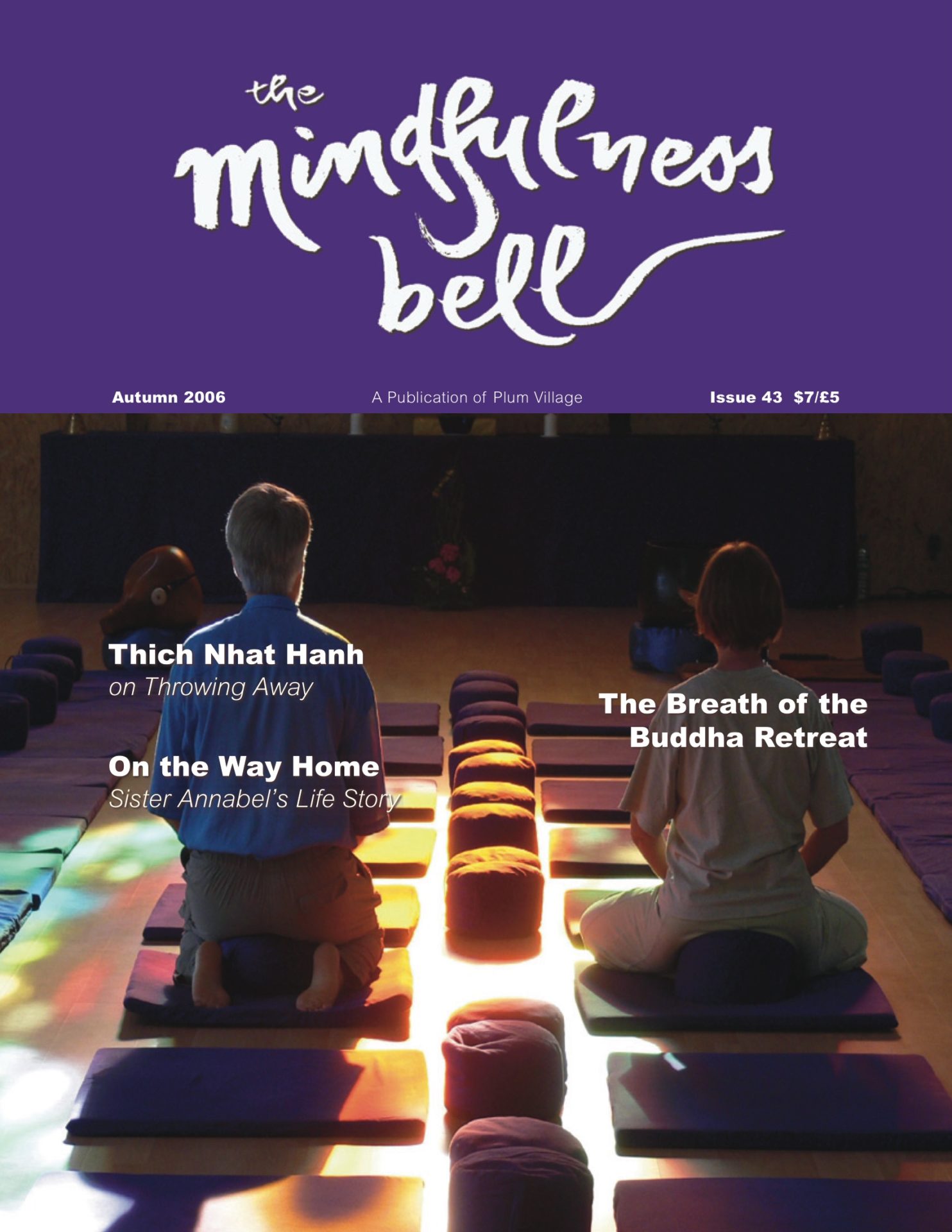By Trish Thompson in October 2006
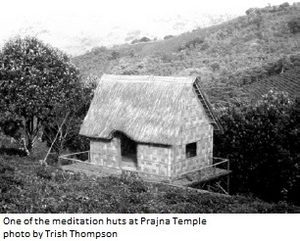
I am living in Hanoi. Am I dreaming? How has this happened? The answers can, as always, be found in the teachings. This is because that is. Manifestation occurs when conditions are sufficient. The understanding of the answers, however, is found in life, and mine has definitely taken some unexpected turns.
When I arrived in Vietnam in January 2005 for the trip with Thây,
By Trish Thompson in October 2006

I am living in Hanoi. Am I dreaming? How has this happened? The answers can, as always, be found in the teachings. This is because that is. Manifestation occurs when conditions are sufficient. The understanding of the answers, however, is found in life, and mine has definitely taken some unexpected turns.
When I arrived in Vietnam in January 2005 for the trip with Thây, I was feeling especially happy and free. I had finally completed a five-year divorce process, the culmination of many years (and perhaps, many lifetimes) of bobbing about in the ocean of suffering. I had lived for decades in a hell realm which left me no alternative but to practice. My teachers, the teachings, and the sangha, as well as my determination and effort, had allowed me to transform the negative energies which had been so all-consuming. Now, how perfect to begin this new phase of my life by traveling and practicing for three months with Thây and the sangha in Vietnam! I had laughingly told friends and family in the U.S. that “I just might not come back.” I was joking, or so I had thought!
Right away, riding into Hanoi from the airport, I felt a strong attraction to the landscape and architecture. The lushness of the rice paddies, and the bent backs and conical hats of those who were working them, stirred something in me. A thought came, “I could live here.”
Over the next weeks, as is usual for me, I fell in love with the sangha and with everything and everyone around me, but something was different. The ocean of suffering had been transformed into a sea of love, and I was swimming in it. The Heart Sutra became real. I was living it. There seemed to be no obstacles for my path, and consequently, the trip unfolded easily. Even though our schedule was very full and the law of impermanence sometimes manifested quickly and unexpectedly, nothing could mar my happiness.
I quickly made wonderful connections with Vietnamese people, first in Hanoi and then in Ho Chi Minh City (HCMC). During a Day of Mindfulness at Van Hanh University, the Buddhist institute in HCMC that Thây had co-founded over 40 years ago, I had surprising encounters with two faculty members and the president, who all agreed that they needed to have a foreigner on staff. And they invited me to return to teach mindfulness meditation and English. Our shared enthusiasm was somewhat tempered when they remembered that for them to receive permission to hire a foreigner would not be easy and would take time. While I knew this invitation might be withdrawn, the seed of possibility had been thoroughly watered.
In segment two, I experienced a strong connection to the land during an overnight visit with Thây and the sangha to Bat Nha [Prajna Temple], the practice center in the central highlands. I felt such profound contentment and immediately visualized myself spending time there. When the announcement was made that Bat Nha would become a Plum Village monastic center, a surge of joy ran through my body.
During Têt, which we celebrated in HCMC, my oracle was read by Sister Chan Khong and Brother Phap Tru. My question was, “I am happy here. I am also happy there. In Vietnam, however, I see love everywhere, especially in the eyes of the people. I want to live here. I want to help build a bridge between the East and the West. How can I do that?” The answer from the Patriarchs came down through the centuries, declaring, “If you meditate consistently in your meditation hut, in a balanced way, all your wishes will come true.” I think I floated out of the meditation hall. Carried by feelings of calm confidence, I had my assignment and somehow I knew I could do it. A few days later, Sister Chan Khong announced that lay friends could invest in the construction of meditation huts at Bat Nha, and I immediately committed.
My future seemed clear. I would live in HCMC. However, several times I heard myself say to others, “I wish something would happen in Hanoi.” Something seemed to be pulling me to that northern city, even though nothing very special had happened to me there. But the trip was not over.
Love and Service in Hanoi
At the end of the three-month tour, I had two nights and three whole days to enjoy being in Hanoi before returning to the U.S. An American lay-sister, a roommate on the tour, suggested that while there, I should meet her cousin, for “he is very interesting, loves living and working in Vietnam, and is a good person for you to know.” I agreed, so she introduced us via e-mail. An American lay-sister suggested I meet an American woman, a Quaker who has lived and worked in the country for more than 30 years.
Conditions were truly sufficient. I met the cousin for dinner, and we agreed to meet for a second evening. I met the woman, and we enjoyed time over lunch. They each, in their own way, urged me to stay, and I did. I postponed my departure for some weeks, then returned to the U.S. only to pack a few things for my move to Hanoi. These life-changing decisions were the easiest I have ever made.
The woman became a dear friend. The man became my beloved and my partner. I was home. I am often asked how I found this partner and this relationship that brings me so much joy. I did not find him, for I was not looking. I was becoming. I became the happy, loving person I wanted to meet, and there he was!
Planting a Dharma Garden
For years, when voicing a wish to become a monastic, I was told to create happiness through sangha building. I tried, but my practice was too weak. Sister Susan said, “Nurture yourself. Plant a garden,” and I did. I withdrew from that which brought no happiness. Several years of gardening were required before flowers could bloom, but with right effort and the support of the sangha, all things are possible.
I received the transmission for membership in the Order of Interbeing in 2002. While that is certainly not a prerequisite for sangha building, my own practice deepened, and in 2003 I started the Sea Island Sangha of Beaufort, South Carolina. I found much happiness in my work there.
The Hanoi Community of Mindful Living (HNCML) became a reality in April 2006. We are a very dedicated group, many of whom are new to the practice. Each week seems to bring one or two experienced practitioners. We are a diverse sangha of many cultures, with both foreign and Vietnamese friends. Our core is made of 15 to 18 people who love to practice together. Already, more than 120 names are on our e-mail list.
Our weekly schedule is quite full, with something for everyone. Early morning sitting and walking meditation is three days a week. A compassionate listening group meets every Tuesday. One evening is devoted to sitting, walking, and Dharma discussion. On another, we chant for peace. Occasionally, we enjoy a special practice or day of mindfulness.
I do not question for a moment why I am in Vietnam. I am here because I am happy here. I am here to build sangha. The roots of my spiritual family are in this land. Sanghabuilding here, I have discovered, is no different from sanghabuilding in South Carolina, and, I suspect, anywhere else. Nurturing myself and taking care of my inner garden is my priority. When I do that, my loving energy is boundless.

Trish Thompson, True Concentration on Peace, recently helped translate and edit an anthology of Vietnamese women’s poetry, to be published by Vietnam’s Women’s Publishing House and the Feminist Press of New York City.
A Recent Evening of Sitting & Chanting at the Hanoi Community of Mindful Living
Linh’s face breaks into a broad smile, as she bows and begins to speak. “I am thirty years old, and I hope I can come to this place forever!” The rest of our group laughs. “I feel so happy here,” she says. “All my colleagues at work tell me I am so much happier, since I began to come to these meetings, and it’s true!” The next to speak is Alan who bows and offers, “I’ve done a lot of work with the mentally ill and the mentally challenged, and I’ve been thinking this week about how I can introduce that population to the practice of chanting. After only a few weeks, I can see that chanting is very healing.” Hang speaks next: “ My whole life has changed since I found this group. I have fallen in love with the teacher, the teachings, and the practice!” Daisuke introduces himself. He has meditated for many years in a Japanese tradition. “I am so surprised at my feelings,” he says as he pats his chest.
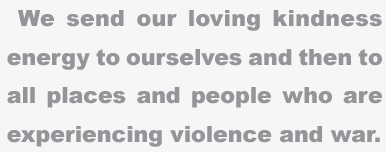
On this Thursday evening, we are a group of eighteen. Chanting is a new practice for our members. We are learning to chant the Opening Verse and the Heart Sutra in English, after which we sit while listening to the Vietnamese version on CD.
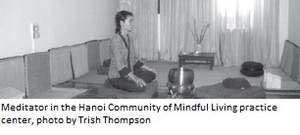
We follow this with twenty minutes of sitting and chanting Namo ‘Valokiteshvara, a weekly practice. We send our loving kindness energy to ourselves and then to all places and people who are experiencing violence and war.
The last thirty minutes we devote to the singing of Plum Village songs. Tonight, we learn “No Coming, No Going” in English. Tam, a seasoned practitioner, sings it in Vietnamese, earning our silent, enthusiastic applause. She agrees to teach us next week. Someone suggests we sing it in French, and we do. Huong, a newcomer, beams and says, “I love singing! My favorite sentence is ‘I am in you, and you are in me.’”
